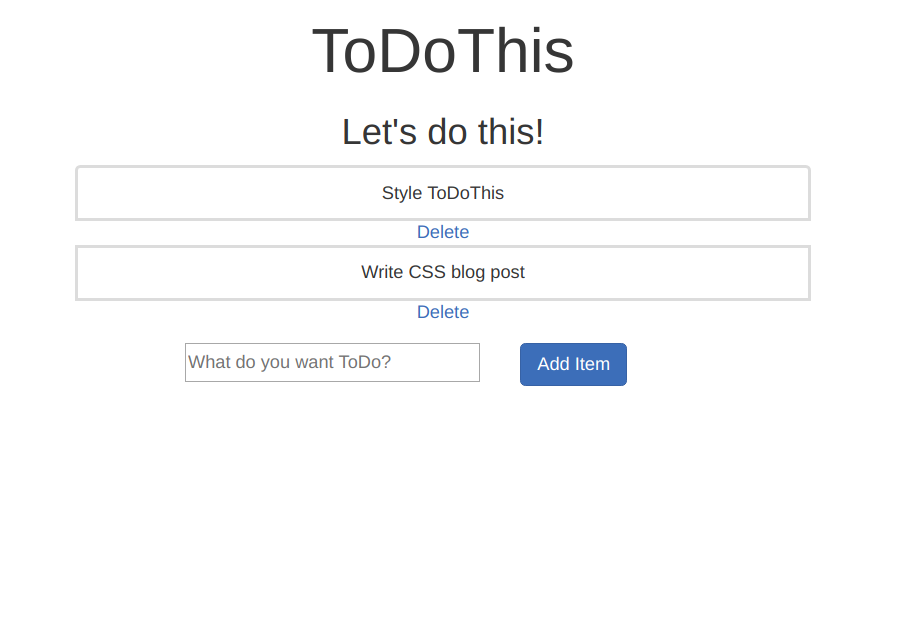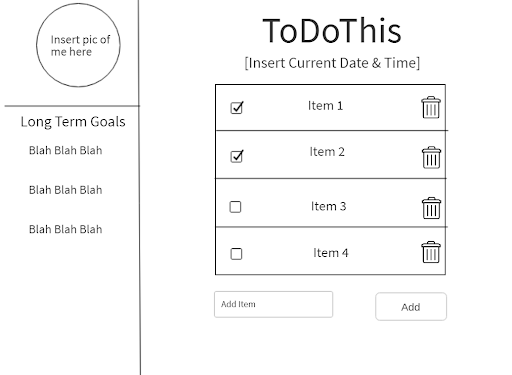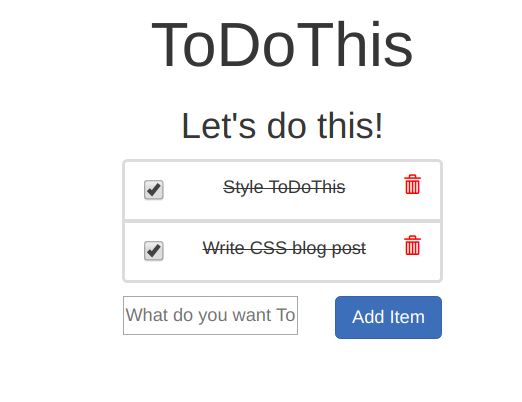Cascading Style Struggles
I think most people struggle to understand CSS, including me. It has been three years since my web development class in junior year of high school where I first learned CSS, and admittedly that’s where my skills with that language peaked. Without constant practice, the technology slowly turns from a science to magic. This is something that I am determined to change about myself. To the common populace, people do not really care or understand complex backend operations, but they can definitely identify when a website looks “aesthetic.” I want to take you along with me on my quest to conquer CSS.

Recently, I’ve been working on a todo list application that I call ToDoThis. Here is the current status of the website:

Not very impressive style-wise, but it gets the job done like any todo list app. It creates items on the list, and you can delete them when you’ve finished them. The improvement I want to make to the frontend of my application is this:

So my first move was to reduce the width of the borders of the todo list items and align the input box and add item button with the borders of the items.
#container
{
text-align:center;
width:25%;
height: 20%;
margin: 0 auto;
}
input
{
width: 17%;
height: 30px;
float: left;
margin-left: 47%;
}
button
{
margin-right: 22%;
float: right;
}Next was to be rid of the awkward placement of the delete feature, and replace it with a trash can icon along with adding in checkboxes that would denote whether a task was completed or not. I also took the liberty of adding in a functionality where if the checkbox was checked off, it would strikethrough the adjacent text.
<div id = "container" class="list-group">
<% todos.forEach( function( todo ) { %>
<span class="list-group-item list-group-item-action">
<input type="checkbox" class="form-check-input" id="check<%= todo._id %>" onclick="isChecked('check<%= todo._id %>', 'content<%= todo._id %>')">
<label class="form-check-label" for="check<%= todo._id %>" id="content<%= todo._id %>">
<%= todo.title %>
</label>
<span id="delete">
<a href="/destroy/<%= todo._id %>" title="Delete this todo item">
<span class="glyphicon glyphicon-trash"></span>
</a>
</span>
</span>
<% }); %>
</div>function isChecked(check_id, content_id){
cbox = document.getElementById(check_id);
content = document.getElementById(content_id);
if(cbox.checked){
content.style.textDecoration = "line-through";
}else{
content.style.textDecoration = "initial";
}
}.list-group-item
{
border: 2px solid #ddd;
}
a
{
color:inherit;
}
#delete
{
float: right;
color: red;
}
.form-check-label
{
font-weight: inherit;
}
.form-check-input
{
float: left;
width: 17px;
height: 17px;
}
So the last thing remaining is to add in that sidebar.
<div class="side-col">
<div id="border-div">
<img id="pfp" src="img/pfp.jpg">
</div>
<div id="ltg">
Long Term Goals:
</div>
</div>html,body
{
height:100%;
}
#pfp
{
width: 200px;
height: 200px;
border-radius: 50%;
}
.side-col
{
margin-left: 2%;
float: left;
height: 100%;
}
#border-div
{
border-right: 2px solid black;
border-bottom: 2px solid black;
}
#ltg
{
font-size: 18pt;
text-align: center;
border-right: 2px solid black;
height: 100%;
}
 And with that, ToDoThis is slightly better styled. Check out my code here
And with that, ToDoThis is slightly better styled. Check out my code here
